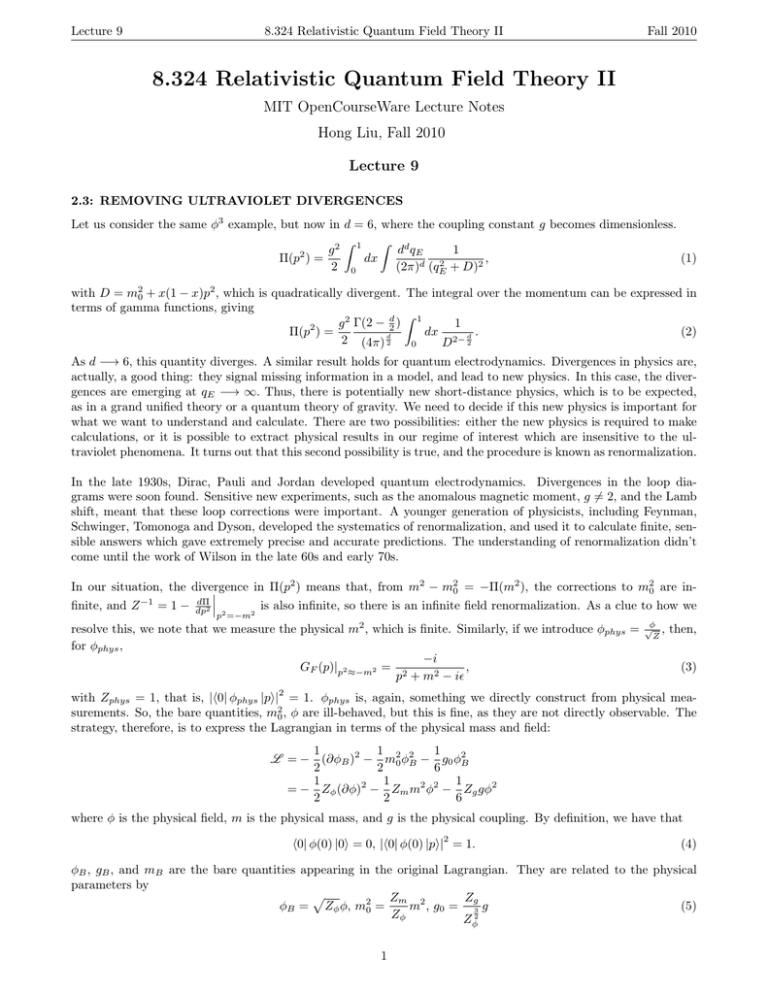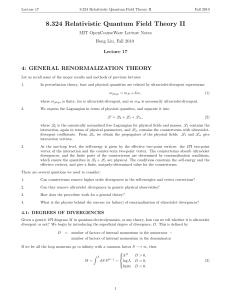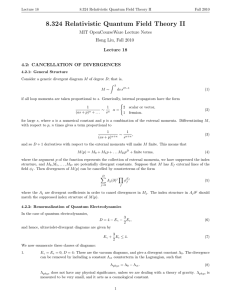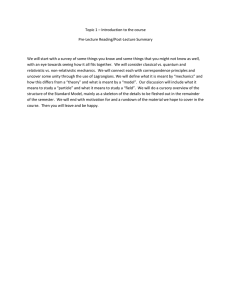Document 13650478
advertisement

Lecture 9 8.324 Relativistic Quantum Field Theory II Fall 2010 8.324 Relativistic Quantum Field Theory II MIT OpenCourseWare Lecture Notes Hong Liu, Fall 2010 Lecture 9 2.3: REMOVING ULTRAVIOLET DIVERGENCES Let us consider the same ϕ3 example, but now in d = 6, where the coupling constant g becomes dimensionless. ˆ ˆ d g2 1 d qE 1 2 Π(p ) = dx (1) 2 + D)2 , 2 0 (2π)d (qE with D = m20 + x(1 − x)p2 , which is quadratically divergent. The integral over the momentum can be expressed in terms of gamma functions, giving ˆ 1 g 2 Γ(2 − d2 ) 1 Π(p2 ) = dx (2) d . 2− 2 (4π) d2 D 2 0 As d −→ 6, this quantity diverges. A similar result holds for quantum electrodynamics. Divergences in physics are, actually, a good thing: they signal missing information in a model, and lead to new physics. In this case, the diver­ gences are emerging at qE −→ ∞. Thus, there is potentially new short-distance physics, which is to be expected, as in a grand unified theory or a quantum theory of gravity. We need to decide if this new physics is important for what we want to understand and calculate. There are two possibilities: either the new physics is required to make calculations, or it is possible to extract physical results in our regime of interest which are insensitive to the ul­ traviolet phenomena. It turns out that this second possibility is true, and the procedure is known as renormalization. In the late 1930s, Dirac, Pauli and Jordan developed quantum electrodynamics. Divergences in the loop dia­ grams were soon found. Sensitive new experiments, such as the anomalous magnetic moment, g ̸= 2, and the Lamb shift, meant that these loop corrections were important. A younger generation of physicists, including Feynman, Schwinger, Tomonoga and Dyson, developed the systematics of renormalization, and used it to calculate finite, sen­ sible answers which gave extremely precise and accurate predictions. The understanding of renormalization didn’t come until the work of Wilson in the late 60s and early 70s. In our situation, the divergence in Π(p2 ) means that, from m2 − m20 = −Π(m2 ), the corrections to m20 are in­ d� is also infinite, so there is an infinite field renormalization. As a clue to how we finite, and Z −1 = 1 − dp 2 2 2 p =−m resolve this, we note that we measure the physical m2 , which is finite. Similarly, if we introduce ϕphys = for ϕphys , −i GF (p)|p2 �−m2 = 2 , p + m2 − iϵ ≈ϕ , Z then, (3) 2 with Zphys = 1, that is, |⟨0| ϕphys |p⟩| = 1. ϕphys is, again, something we directly construct from physical mea­ surements. So, the bare quantities, m20 , ϕ are ill-behaved, but this is fine, as they are not directly observable. The strategy, therefore, is to express the Lagrangian in terms of the physical mass and field: 1 1 1 L = − (∂ϕB )2 − m20 ϕ2B − g0 ϕ2B 2 2 6 1 1 1 = − Zϕ (∂ϕ)2 − Zm m2 ϕ2 − Zg gϕ2 2 2 6 where ϕ is the physical field, m is the physical mass, and g is the physical coupling. By definition, we have that 2 ⟨0| ϕ(0) |0⟩ = 0, |⟨0| ϕ(0) |p⟩| = 1. (4) ϕB , gB , and mB are the bare quantities appearing in the original Lagrangian. They are related to the physical parameters by √ Zm 2 Zg ϕB = Zϕ ϕ, m20 = m , g0 = 3 g (5) Zϕ Z2 ϕ 1 Lecture 9 8.324 Relativistic Quantum Field Theory II Fall 2010 where Zϕ , Zm and Zg are potentially divergent. We now write L = L0 + LI + Lct (6) with 1 1 L0 = − (∂ϕ)2 − m2 ϕ2 , 2 2 1 2 LI = − gϕ , 6 1 1 1 Lct = − A(∂ϕ)2 − Bm2 ϕ2 − Cgϕ2 , 2 2 6 where A = Zϕ − 1, B = Zm − 1, C = Zg − 1. Remarks 1. A, B and C are potentially divergent, but that is allowed, as they are not observable. 2. Since tree-level diagrams do not change m2 , ϕ or g, the differences between bare and physical quantities come from loop corrections. In perturbation theory, A, B, C ∼ O(g 2 ) and higher. 3. We have a set of modified Feynman rules p = −i , p2 + m2 − iϵ = ig, = −Ap2 − Bm2 , p = iC. (7) with the counter-terms treated as additional vertices. 4. A, B, and C will be determined order by order in perturbation theory as follows: again, iGF (p2 ) = p2 + m2 1 , − Π(p2 ) − iϵ (8) but now, to O(g 2 ) Π(p2 ) = + , and we have a contribution from the counter-term vertex. We now require Π(p2 = −m2 ) = 0 : the physical mass condition, and dΠ 2 (p = −m2 ) = 0 : the physical field condition. dp2 2 (9) Lecture 9 8.324 Relativistic Quantum Field Theory II Fall 2010 giving two constraints which can be solved to find A and B. A similar condition for the interaction vertex: ig = , (10) can be used to determine C, but we will not discuss that here. Let us now determine A and B to O(g 2 ). To deal with divergent quantities, we first need to regularize them, for example by introducing a momentum cutoff : ˆ ˆ � d g2 1 d qE 1 2 2 Π(p2 ) = dx (11) 2 + D)2 − Ap − Bm , 2 0 (2π)d (qE taking the limit Λ −→ ∞ at the end. Now, D = m2 + x(1 − x)p2 ; that is, m0 has been replaced with m. It is often more convenient to use a method known as dimensional regularization. For general d, ˆ g 2 Γ(2 − d2 ) 1 1 2 2 2 Π(p ) = dx (12) d − Ap − Bm , 2− 2 (4π) d2 D 2 0 and for d = 6, Γ(2 − d2 ) = Γ(−1) is divergent. We will instead take d = 6 − ϵ, taking the limit ϵ −→ 0 at the end. ϵ Note that [g] = 2ϵ in d = 6 − ϵ dimensions. It is convenient to write g −→ gµ 2 , where g is now dimensionless and µ is some arbitrary mass scale. Hence, ˆ ϵ g 2 µϵ Γ(−1 + 2ϵ ) 1 Π(p2 ) = dx D1− 2 − Ap2 − Bm2 . (13) ϵ 3− 2 (4π) 2 0 The steps are now to expand in ϵ, absorbing the divergent parts into A and B, and then to use the physical mass 2 and field conditions to determine the finite parts of A and B. Introducing α ≡ (4gπ)3 , and using the expansion Γ(1 + 2ϵ ) = − 2ϵ + (γ − 1) + O(ϵ), where γ is the Euler number, we have Π(p2 ) = α 2 (− ) 2 ϵ ˆ 1 dx D + 0 [ ] ˆ 1 ˆ 1 α 4πµ2 (γ − 1) dx D − dx D log − Ap2 − Bm2 + O(ϵ). 2 D 0 0 (14) ´1 2 We note that 0 dx D = m2 + p6 . So, the divergence can indeed by cancelled by A and B. Introducing D0 = D(p2 = −m2 ) = m2 (1 − x(1 − x)), we have ( ) ˆ α 1 D α 2 D0 p2 − + (γ − 1) + log( Π(p2 ) = dx D log( )+ ) (m2 + ) − Ap2 − Bm2 + O(ϵ), (15) 2 2 0 D0 2 ϵ 4πµ 6 and so, cancelling the divergent parts into A and B, we have a finite remainder ˆ α 1 D Π(p2 ) = dx D log( ) + ap2 + bm2 . 2 0 D0 (16) We now impose the physical mass and physical field conditions, giving Π(p2 = −m2 ) = 0 ⇒ a = b dΠ 2 α (p = −m2 ) = 0 ⇒ a + dp2 2 ˆ 1 dx x(1 − x) = 0. 0 α And so, we find a = b = − 12 , and our final result is α Π(p ) = 2 ˆ 2 1 dx D log( 0 which is completely finite and well-defined. Remarks: 3 D α ) − (p2 + m2 ) D0 12 (17) Lecture 9 1. 8.324 Relativistic Quantum Field Theory II Fall 2010 For A and B, we have Ap2 + Bm2 = α 2 ( ) 2 D0 p2 α − + (γ − 1) + log( ) (m2 + ) + (p2 + m2 ), 2 ϵ 4πµ 6 12 (18) which is completely determined, and divergent as ϵ −→ 0. Note that the expression is O(α) where 2 α = (4gπ)3 . 2. While A and B depend on the mass scale µ, which was introduced arbitrarily, physical quantities like Π(p2 ) do not depend on µ. 3. For large p2 , D ∼ p2 x(1 − x), and so [ ] p2 2 2 2 Π(p2 ) 2 = α c1 p + c2 m + c3 p log( 2 ) . p −�� m 2 2 (19) p p If m 2 is large, α log( m2 ) can be large and perturbation theory can become invalidated. Later, we will discuss this in the context of the renormalization group. 4 MIT OpenCourseWare http://ocw.mit.edu 8.324 Relativistic Quantum Field Theory II Fall 2010 For information about citing these materials or our Terms of Use, visit: http://ocw.mit.edu/terms.






